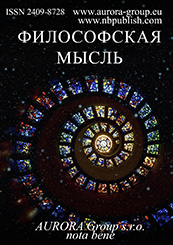Spectrum of consciousness
Reference:
Mamarasulov, A.R. (2025). The main provisions of the "essential" model of mind. Philosophical Thought, 3, 1–21. https://doi.org/10.25136/2409-8728.2025.3.73315
Abstract:
The subject of the research is a philosophical model of mind based on the primacy of essential characteristics over structural ones. The object of research is the essential characteristics of intelligent cognition, considered in the context of this model. The author explores such aspects of the topic as: the existence of common philosophical grounds for defining reason as an entity, the substantive and conceptual difference between the theoretical model defining reason as an entity and the structural model of reason. Special attention is paid to the disclosure of such characteristics of rational cognition as: the comprehensive and self-identical nature of reason; the immutability of the nature of reason as an entity; the relationship between the essential and teleological aspects of reason; the phenomenon of accumulation and optimization of rational experience as an essential attribute of reason; the problematic philosophical understanding of rational cognition as a process of achieving a supernatural goal. The typological method was applied to classify the epistemological models under consideration. The method of system analysis was used to identify the basic provisions of each model. The main conclusions of the conducted research are. In the "essential" model, the mind is understood as a self-identical form that has no supernatural purpose. The connection between the essence of reason and its teleological character represents the identity underlying the progressive movement of cognition. The "essential" model of mind in its basic positions has a theoretical priority over the "procedural" model, which defines the mind as a structure. The theoretical conclusions obtained are consistent with the practical goals of reason. The essential understanding of the nature of rational cognition should be recognized not only as a philosophically sound, but also as a constructive concept. The author's special contribution to the research of the topic is an attempt at a detailed analysis and reasoned justification of the basic provisions of the "essential" model of reason. The novelty of the research lies in the fact that the topic is raised in the context of bioethics, which defends the primacy of the natural essence of man over ideas in which the possibility of its structural transformation is allowed.
Keywords:
essence of reason, model of reason, essence, simple, complex, purpose, teleology, the ultimae purpose, structure, reason
Tradition and innovation
Reference:
Sayapin, V.O. (2025). The role of the concept of “pre-individual” in philosophy Gilbert Simondon and Bernard Stiegler. Philosophical Thought, 3, 22–33. https://doi.org/10.25136/2409-8728.2025.3.73130
Abstract:
One of the very few who, along with Gilles Deleuze (1925–1995), recognized from the very beginning the importance of the philosophical works of the outstanding philosopher and thinker in the field of technology and technological innovation Gilbert Simondon (1924–1989) was the famous philosopher and anthropologist Bernard Stiegler (1952–2020). In his works, Stiegler not only directly refers to the works of this thinker, but also continues his thoughts, just as Simondon himself conducted a “dialogue” with Henri Bergson (1859–1941). However, the nature of this new dialogue is so specific that Stiegler questions the status of “first philosophy”, which Simondon, following Bergson, attributed to the philosophy of nature understood as cosmogenesis (Bergson) or ontogenesis (Simondon). In this case, as specific research methods for constituting the concept of the Simondon's "pre-individual" and the Stiegler's idea of the original technological nature of this pre-individual, we use such general scientific approaches as the descriptive method, the method of categorization, the method of analysis, the method of observation, the genetic method and the comparative-contrastive method. Hence, the goal of our research is not only to refute the critical assessment expressed by Stiegler in relation to Simondon, but also to successfully understand the specificity of ontogenesis, we will try to solve the following problems: 1) to reveal the philosophical understanding of the hypothesis of the pre-individual state of being, from which any phase of individuation (physical, biological, mental or psychosocial) comprehended as being flows; 2) to investigate the reasons why Stiegler has grounds to accuse Simondon of not having fully thought through the psychosocial (transindividual) phase of individuation; 3) discuss Stiegler's additional step, which ultimately recognizes the intrinsically technological dimension of the pre-individual.
Keywords:
hylomorphism, formation, metastability, individuation, pre-individual being, ontogenesis, Bernard Stiegler, Gilbert Simondon, technical object, artifact
Philosophy of religion
Reference:
Pozdnyakov, A.V. (2025). The peculiarity of Aldous Huxley's methodological approach to understanding religious experience. Philosophical Thought, 3, 34–56. https://doi.org/10.25136/2409-8728.2025.3.73647
Abstract:
The subject of this study is the methodological approach used by Aldous Huxley to study religious experience and mystical experiences. The article pays special attention to the theoretical origins of this methodology, as well as the social and cultural context of its formation. The article examines how science, philosophy, and religion of that time contributed to the formulation of Aldous Huxley's methodological approach. The author of the article examines which principles and methods formed the basis of Huxley's methodology, how the principle of objectivity of scientific knowledge with the subjectivity of personal experience is consistent in the applied approach. The article also examines his experimental use of mescaline to explore the depths of human consciousness and search for a "divine foundation", analyzes the results and limitations of Huxley's methodological approach and his contribution to understanding the nature of religious experience. This article is based on methodological approaches such as biographical and comparative historical methods, as well as an analytical study of sources and their systematization. The work used a comprehensive analysis of Huxley's texts to identify key aspects of his worldview. The scientific novelty lies in the fact that a holistic reconstruction of Huxley's methodology used by him for the study of religious experience has been carried out. Based on sources, the author shows how it developed from the late 1920s to 1960. The article analyzes not only key works, but also little-known essays and lectures, some of which have not been published in Russian. Huxley's interest in religious experience stems from personal experiences and cultural context. His methodology includes philosophical, psychological, and anthropological aspects, focusing on the phenomenology of religious experience. Huxley conducts a comparative analysis of various religious traditions, identifying common features and a universal spiritual reality. He strives to integrate scientific methods with mystical ones based on critical analysis, facts and experimentation. In theoretical analysis, he juxtaposes binary categories such as body-mind and religion-magic, emphasizing the importance of bodily experience in spiritual enlightenment. Also, as an important conclusion, the strengthening of the body-oriented principle in understanding religious and mystical experience in the last decade of the thinker's life should be noted.
Keywords:
phenomenology, introspection, method of knowledge, philosophical essay, Aldous Huxley, religious experience, philosophy of religion, Mysticism, psychology of religion, bodyness
Philosophy of religion
Reference:
Sokolov, A.V. (2025). Progressivism as a variety of eschatological myth. Philosophical Thought, 3, 57–76. https://doi.org/10.25136/2409-8728.2025.3.72675
Abstract:
The article explores progressivism as a continuation of the eschatological tradition within European rationalism. It analyzes how the ideas of linear progress, formulated during the Enlightenment, became a secularized version of religious eschatological concepts. It examines how modernity, despite its rationalist orientation and scientific criteria, itself develops apocalyptic motifs of salvation in the form of science and technological advancement. A comparative analysis of scientific rationalism and the eschatological myth reveals their structural similarities. As a contrasting element, the “palingenetic myth” is also considered, offering deeper insight into the features of the eschatological model. The object of study is progressivism and its “temporal paradigm” as part of the European tradition of scientific rationalism, while the subject is eschatology as the root of progressivism. The article employs the following scientific methods: metatheory and philosophy of science, the historical method, and evolutionism as a scientific approach. Its scholarly contribution lies in analyzing the relationship between “myth” and the “temporal paradigm” of modern science, demonstrating that the latter, contrary to rationalist logic, is not an “abstract point of reference.” Myth is considered a concrete, sensuous reality shaping the perception of the world, including that of the scientist and science itself. The study argues that even within rationalism and progressivism, eschatological concepts retain their mythological structure, raising questions about the true nature and trajectory of science and the possibility of its emancipation from myth. In this context, the research offers a new perspective on the interplay between scientific and mythological categories, emphasizing their role in ordering the chaos of the surrounding world and shaping cultural identity.
Keywords:
european rationalism, Eschatology in philosophy, Palingenesis in philosophy, Temporal paradigm, religious archetype, Palingenetic myth, eschatological myth, Eurocentrism, Palingenesis, Eschatology
Philosophy of technology
Reference:
Larionov, V.V. (2025). Concepts of the visible and invisible enemy as antagonistic components determining the success of military confrontation (using optical devices as an example). Philosophical Thought, 3, 77–88. https://doi.org/10.25136/2409-8728.2025.3.73462
Abstract:
The emergence of remote weapons and the improvement of their tactical and technical characteristics geographically distanced the warring parties from each other, which made it possible to consider the concept of remote warfare involving the visible/invisible enemy and detect/hide dichotomies. The object of the research is the phenomenon of (non)visibility of combatants and military equipment during combat operations. The subject of the study is the practice of detecting the enemy and hiding their units by combatants in military operations based on the application of the laws of optics. The concepts of the visible and invisible enemy have been widely studied within the framework of modern technical warfare, at the same time, the processes of transition from a state of visibility to a state of invisibility and back by direct participants in military operations based on the application of the laws of optics are currently not fully understood. As a methodological basis for conducting a systematic study, the following can be used: historical and philosophical reconstruction, the concept of simulacrum of Baudrillard and the panopticism of M. Foucault. The novelty of the research consists in identifying and describing the concepts of a visible and invisible enemy as antagonistic components that determine the success of military confrontation (using optical devices as an example). The border of (non-)visibility is not stable, its deviant nature determines both the level of development of military art and weapons, as well as the natural and geographical features of the military operations. For this reason, the success of conducting an armed confrontation is actively shifting towards outstripping the enemy in implementing practices to transform his invisible objects into visible, open and calculable ones. Optical devices have certainly enhanced human vision, allowing within certain limits to destroy the boundaries of the perceptual inaccessibility of the enemy, but at the same time, knowledge of the laws of light propagation and refraction can significantly complicate the spatial identification of search objects. The surveillance process in modern warfare has become not only continuous and comprehensive, but has also transformed into a decentered, dynamic and panoptic surveillance aimed at timely detection of threats and their preventive elimination.
Keywords:
a technical war, the theory of countershading, the simulacrum, retroreflectum, panopticism, optical device, the invisible enemy, disguise, the kill box concept, photo analysis
 This work is licensed under a Creative Commons Attribution-NonCommercial 4.0 International License.
This work is licensed under a Creative Commons Attribution-NonCommercial 4.0 International License.










 © 1998 – 2025 Nota Bene. Publishing Technologies. NB-Media Ltd.
© 1998 – 2025 Nota Bene. Publishing Technologies. NB-Media Ltd.




